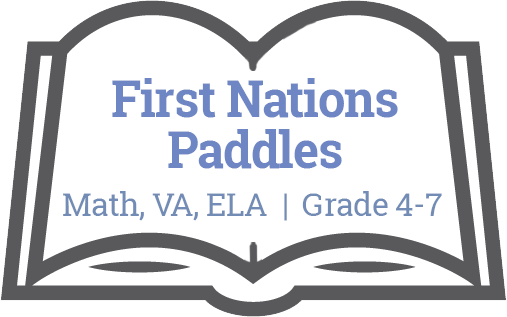
Unit Plan: First Nations Paddles
Math, Visual Arts, Language Arts / Grade 4-7

Big Ideas
Polygons are closed shapes with similar attributes that can be described, measured, and compared (Grade 4 Math)
Closed shapes have area and perimeter that can be described, measured, and compared. (Grade 5 Math)
Properties of objects and shapes can be described, measured, and compared using volume, area, perimeter, and angles. (Grade 6 math)
Creative expression is a means to explore and share one’s identity within a community. (Grade 4 Art)
Works of art influence and are influenced by the world around us. (Grade 5 Art)
Experiencing art is a means to develop empathy for others’ perspectives and experiences. (Grade 6 Art)
Engaging in the arts develops people’s ability to understand and express complex ideas. (Grade 7 Art)
Exploring stories and other texts helps us understand ourselves and make connections to others and to the world. (Grade 4-7 ELA)
Concepts:
- Geometry
- Elements and principles of design
- Form
- The Writing Process
- Oral Storytelling
Essential Questions
Students will keep considering…
VISUAL ARTS
- How does art connect us, our communities, and our cultures?
MATH
- How does geometry help us make sense of the world?
LANGUAGE ARTS
- How does oral storytelling connect us to places and people?
- How can an open mind lead us to deeper understandings about ourselves and other cultures?
- Why does writing have a purpose?
Evaluative Criteria
Teacher Evaluative Criteria:
Teachers will be assessing students’ ability to:
- Create design that incorporates traditional Aboriginal design elements
- Make connections between the Aboriginal shapes and 2D shapes and 3D solids
- Work through the writing process
- Share their story orally
Monitoring Progress
Teacher will monitor progress:
Formative Assessment throughout: During class discussions, small group discussions and one on one conversations
Potential Student Misunderstandings:
N/A
Resources
- Examples of Coast Salish shapes and art
- Colouring Sheets that show a variety of First Nations shapes
- First Nations Support Workers/Aboriginal Success Teacher
- BLM of paddle shape
- Literacy 44 Graphic Organizers for How To Writing, Pourquoi Tales, and Story Writing Frames
Reflection
How will teachers and their students reflect on and evaluate the completed project?
Teacher:
Next time I teach this unit I would…
Student:
My students needed:
Process:
Product:
Content:
Potential Student Misunderstanding:
Downloads
Unit Overview
Subject
Math, Visual Arts, Lanuage Arts
Topic
First Nations Paddles
Unit Overview
This unit is an interdisciplinary unit that explores shapes you typically see in Coast Salish and other First Nations works of art. Students begin by exploring 2D and 3D shapes in math, and making connections to the typical First Nations shapes (i.e. ovoid, split-u, etc). After this, student are asked to create their own paper paddle design that incorporates these shapes, using a template and some method of colouring them in. Lastly, once the paddles have been completed, students work through the writing process to create a story of their paddle (i.e. how they made it, the story it represents), that they can then share orally.
Grade
4-7
Unit Duration
4 weeks
Related Big Ideas
Math: 4-7
Visual Arts: 4-7
Language Arts: 4-7

The following resources are made available through the British Columbia Ministry of Education. For more information, please visit BC’s New Curriculum.
Big Ideas
The Big Ideas consist of generalizations and principles and the key concepts important in an area of learning. The Big Ideas represent what students will understand at the completion of the curriculum for their grade. They are intended to endure beyond a single grade and contribute to future understanding.
Core Competencies
 Communications Competency
Communications Competency
The set of abilities that students use to impart and exchange information, experiences and ideas, to explore the world around them, and to understand and effectively engage in the use of digital media
 Thinking Competency
Thinking Competency
The knowledge, skills and processes we associate with intellectual development
 Social Competency
Social Competency
The set of abilities that relate to students’ identity in the world, both as individuals and as members of their community and society
Curricular Competencies & Content
Curricular Competencies are the skills, strategies, and processes that students develop over time. They reflect the “Do” in the Know-Do-Understand model of curriculum. The Curricular Competencies are built on the thinking, communicating, and personal and social competencies relevant to disciplines that make up an area of learning.
Additional Resources
First People's Principles of Learning
To read more about First People’s Principles of Learning, please click here.
For classroom resources, please visit the First Nations Education Steering Committee.
